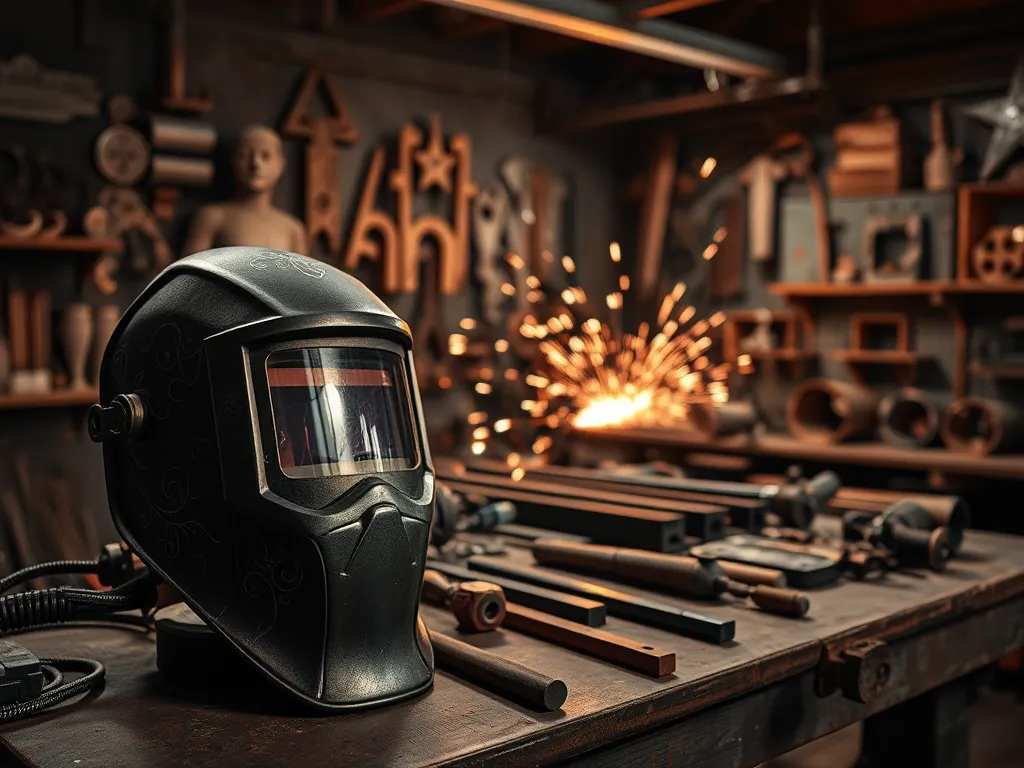Master Welding: How to Teach Yourself to Weld Like a Pro

A Comprehensive Guide to Welding: Techniques, Safety, and Resources
Welding is a vital fabrication and manufacturing process that joins materials together through high heat and pressure, typically involving metals or thermoplastics. This essential technique has become a cornerstone of various industries, including construction, automotive, and aerospace. Recognized for its ability to create strong and durable joints, welding offers a plethora of methods that cater to different applications, making it a critical skill for tradespeople and engineers.
If you're looking to improve your welding skills, this is the perfect place to teach yourself.
The welding process can vary significantly based on the materials being joined and the desired outcome. For instance, methods like MIG (Metal Inert Gas) welding are popular for their speed and ease of use, making them perfect for beginners and high-volume projects. On the other hand, TIG (Tungsten Inert Gas) welding is favored for its precision, allowing for exceptional bead quality and control. Each welding technique presents unique challenges and advantages, necessitating an understanding of their fundamentals for successful application.
With the advancement of technology, welding has evolved, introducing semi-automated and robotic welding techniques that enhance efficiency, consistency, and quality. While traditional welding methods exist, these advancements are indispensable for modern manufacturing processes. Furthermore, the importance of safety cannot be overstated, as welding involves hazardous materials and fumes, requiring diligent safety practices and equipment to protect welders from potential threats.
In addition to practical skills, aspiring welders can benefit from various resources for learning and enhancing their craft. From online courses to community forums, the wealth of information available empowers individuals to refine their skills and stay updated on the latest welding trends. As such, lifelong learning is a crucial aspect of professional development in the welding field, ensuring welders remain competitive and proficient in their techniques.
For those eager to learn to weld, here's a great starting point.
Ultimately, welding is not just a job; it is an art form that enables individuals to bring their creative visions to life. From constructing robust structures to crafting intricate sculptures, the versatility of welding offers tremendous opportunities for personal expression and professional growth. This comprehensive guide aims to provide insights into essential welding techniques, safety practices, tools, resources, and projects for practicing welding skills.
Essential Welding Techniques
Understanding MIG Welding Basics: MIG welding is one of the most commonly used welding processes. It utilizes a continuous wire feed to create an arc between the wire and the workpiece. This method is favored for its speed, ease of use, and versatility, making it suitable for various materials and thicknesses. It's particularly popular among beginner welders due to its forgiving nature, allowing for effective welding even with some imperfections in technique. Familiarizing oneself with MIG welding basics is crucial for building a solid foundation in welding practices.
This welding tutorial is ideal for beginners aiming to master the basics.
Mastering TIG Welding Methods: TIG welding is another essential technique that offers superior control and precision. This method uses a non-consumable tungsten electrode to produce an arc, which requires a filler material to be added manually. TIG welding is highly regarded for its clean and aesthetically pleasing welds, making it ideal for applications where appearance matters, such as in automotive and art projects. Mastering TIG welding requires practice and skill, particularly in advance techniques like stringer beads and weave patterns.
Learning Stick Welding Fundamentals: Stick welding, formally known as Shielded Metal Arc Welding (SMAW), is one of the oldest welding techniques. It involves the use of a consumable electrode coated in flux to produce a weld. Stick welding is revered for its portability and is often used in outdoor and fieldwork environments. Understanding the fundamentals of stick welding, including electrode selection and rod manipulation, is crucial for effective execution in various welding conditions.
Exploring Flux-Cored Welding: Flux-cored arc welding (FCAW) is another popular method that is similar to MIG welding but uses a tubular wire filled with flux. This technique provides a protective gas shield, enabling effective welding in outdoor conditions. Flux-cored welding is particularly beneficial for heavy fabrication and construction projects, where atmospheric conditions can be challenging. Exploring this welding method broadens a welder’s capabilities and adaptability in diverse work environments.
Advanced Welding Techniques for Pros: Once basic welding skills are acquired, advanced techniques such as multi-pass welding and underwater welding can be explored. These methods require more dexterity and understanding of complex welding scenarios. Advanced welders often engage in specialized training to master such techniques, empowering them to tackle intricate projects and meet the demands of various industries with confidence.
Welding Safety Practices
Essential Safety Gear for Welders: Safety in welding is paramount; therefore, wearing proper personal protective equipment (PPE) is essential. This includes welding helmets with appropriate lenses, flame-resistant clothing, gloves, and safety boots. Each piece of gear protects welders from harmful fumes, sparks, and heat, ensuring a safe working environment. Investing in quality safety gear not only safeguards health but also enhances performance during welding processes.
Understanding Welding Hazards: Welders must be aware of the potential hazards associated with their work. Common welding dangers include exposure to ultraviolet light, electrical shock, burns, and inhalation of harmful fumes. Understanding these hazards is the first step toward mitigating risks and implementing safe working practices. Additionally, knowledge of materials being used and their specific risks is vital for ensuring a safe workspace.
Proper Workspace Setup for Safety: A well-organized and safe workspace is crucial for effective welding. Proper ventilation is essential to minimize fume exposure, while ensuring that work areas are clear of unnecessary materials can prevent accidents. Fire safety measures, such as having extinguishers on hand and removing flammable items, further contribute to a safe welding environment. Regular maintenance and safety checks can help identify and rectify any potential hazards.
Emergency Procedures in Welding: Training and preparation for emergencies can make all the difference during a welding accident. Understanding how to respond in case of fire, electrical shock, or toxic fume exposure is critical. Employing emergency procedures, including knowing the location of first aid kits and emergency exits, fosters a safety-conscious culture in welding environments. Regular drills and reminders can ensure that all welders are prepared for any situation.
First Aid Basics for Welding Injuries: In the event of a welding-related injury, knowing basic first aid procedures can be incredibly beneficial. For minor burns, cool the affected area with lukewarm water and cover with a sterile dressing. For more serious burns or electrical injuries, immediate medical attention is crucial. Additionally, addressing fume inhalation requires getting the affected individual to fresh air and monitoring their breathing. Promoting first aid knowledge among welders enhances workplace safety.
Tools and Equipment for Welding
Must-Have Welding Tools for Beginners: For those starting in welding, having the right tools is crucial. Beginner welders should invest in basic equipment such as a welding machine, welding helmet, gloves, and appropriate materials. Additional tools like pliers, a wire brush, and safety goggles will enhance the welding experience and ensure quality results. Understanding the functionality of each tool can greatly ease the learning process and promote effective welding techniques.
Choosing the Right Welding Machine: Selecting the right welding machine is essential for successful welding projects. Welders must consider factors such as the types of materials they will be working with, required welding processes, and voltage needs. MIG, TIG, and stick welding machines vary in features, capabilities, and ease of use. Researching and comparing different models based on personal needs and skill levels can ensure the right investment in quality equipment.
Gas vs Electric Welding Tools: The choice between gas and electric welding tools largely depends on the application and environment. Gas welding often provides portability and is ideal for home repairs and maintenance. In contrast, electric welding tools are highly effective for high-production settings, offering reliable power and versatility. Understanding the differences and benefits of each type can greatly influence a welder's ability to adapt to different projects.
Maintenance Tips for Welding Equipment: Proper maintenance of welding equipment is crucial for both safety and performance. Regularly checking and cleaning the welding machine, inspecting hoses and connections, and replacing worn-out parts can enhance the lifespan and efficiency of the tools. Keeping a maintenance schedule and addressing issues promptly prevents equipment failure and promotes a safe working environment.
Upgrading Your Welding Setup: As skills and project demands evolve, so too should a welder's equipment. Upgrading welding machines, investing in advanced tools, or incorporating new technologies can enhance efficiency and capabilities. Staying informed about developments in welding technology and equipment allows welders to make informed decisions about future investments for their setup.
Welding Resources and Training
Online Welding Courses and Tutorials: The accessibility of online courses has transformed how individuals learn welding techniques. Numerous platforms offer comprehensive welding education ranging from beginner basics to advanced skills. These online resources often include instructional videos, quizzes, and forums for discussion. Enrolling in such courses provides exciting opportunities for skill enhancement and personal development in the field of welding.
Books and Manuals for Self-Learners: For self-learners, books and manuals serve as invaluable resources. Numerous publications cover various aspects of welding, including theory, technical references, and practical applications. By utilizing these written resources, aspiring welders can solidify their understanding of welding processes, techniques, and best practices, paving the way for successful hands-on experiences.
Joining Welding Communities and Forums: Engaging with welding communities and online forums is another way to enhance welding knowledge and skills. These platforms offer opportunities for networking, sharing experiences, and seeking guidance from fellow welders. Additionally, forums often feature discussions about techniques, equipment reviews, and troubleshooting advice, fostering a collaborative learning environment.
Finding Local Welding Workshops: Local welding workshops provide hands-on experience and the chance to learn from experienced professionals. Many technical colleges and vocational schools offer welding courses where individuals can practice techniques in a structured setting. Attending these workshops can enhance skill sets, provide valuable feedback, and foster connections within the welding community.
YouTube Channels for Welding Tips: YouTube is a fantastic source of welding tutorials and tips. Many experienced welders and educators share valuable insights, demonstrations, and troubleshooting advice through engaging video content. Subscribing to channels focused on welding education can supplement formal training and provide visual confirmation of various techniques, making the learning process more accessible and enjoyable.
Projects for Practicing Welding Skills
Simple Welding Projects for Beginners: Beginners can practice their welding skills through simple projects that allow for experimentation and learning. Projects such as making a small metal rack, brackets, or a simple frame provide opportunities for hands-on experience with different techniques while solidifying foundational skills. Starting with manageable projects boosts confidence and encourages further exploration of more complex applications.
Intermediate Projects to Improve Skills: As budding welders gain confidence, they can tackle intermediate projects that challenge their abilities. Projects like building a garden bench, creating gates, or fabricating custom tools enhance welding techniques and foster creativity. These projects allow welders to apply their newly acquired skills and experiment with different materials and welding methods.
Advanced Welding Challenges: For experienced welders, advanced projects present opportunities to push the limits of their skills. Fabricating complex structures, repairing machinery, or creating intricate art pieces can be enriching experiences. Advanced challenges require problem-solving, creativity, and technical expertise, allowing welders to showcase their mastery and expand their capabilities.
Creating Art with Welding Techniques: Welding isn't just about practicality; it can also be an artistic endeavor. Many welders explore creating sculptures, decorative pieces, or functional art using their welding skills. This intersection of art and craftsmanship allows welders to express their creativity while honing their technical proficiency, making projects both fulfilling and visually striking.
Repair Projects to Enhance Skills: Engaging in repair projects provides practical hands-on experience while enhancing welding skills. Whether it’s fixing old tools, vehicles, or household items, these projects allow welders to apply their knowledge in real-world situations. Repairing items not only extends their lifespan but also offers valuable learning experiences with various repair techniques and materials.
